Related Research Articles

The Sorrows of Young Werther, or simply Werther, is a 1774 epistolary novel by Johann Wolfgang Goethe, which appeared as a revised edition in 1787. It was one of the main novels in the Sturm und Drang period in German literature, and influenced the later Romantic movement. Goethe, aged 24 at the time, finished Werther in five and a half weeks of intensive writing in January to March 1774. It instantly placed him among the foremost international literary celebrities and was among the best known of his works. The novel is made up of biographical and auto-biographical facts in relation to two triangular relationships and one individual: Goethe, Christian Kestner, and Charlotte Buff ; Goethe, Peter Anton Brentano, Maximiliane von La Roche, and Karl Wilhelm Jerusalem, who died by suicide on the night of Oct 29 or 30, 1772. He shot himself in the head with a pistol borrowed from Kestner. The novel was adapted as the opera Werther by Jules Massenet in 1892.
This article contains information about the literary events and publications of 1773.
This article contains information about the literary events and publications of 1779.
This article contains information about the literary events and publications of 1786.
This article contains information about the literary events and publications of 1787.
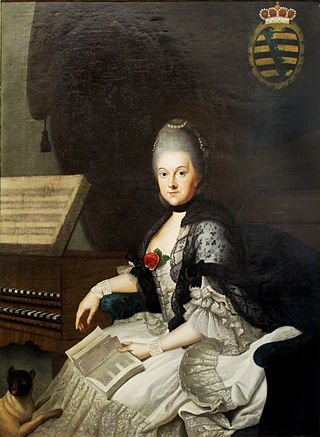
Anna Amalia of Brunswick-Wolfenbüttel, was a German princess and composer. She became the duchess of Saxe-Weimar-Eisenach by marriage, and was also regent of the states of Saxe-Weimar and Saxe-Eisenach from 1758 to 1775. She transformed her court and its surrounding into the most influential cultural center of Germany. Her invitation of Abel Seyler's theatre company in 1771 marked the start of Weimar Classicism, that would include such figures such as Wieland, Goethe, Herder and Schiller working under her protection.
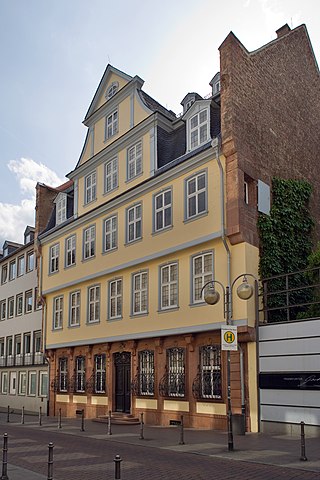
The Goethe House is a writer's house museum located in the Innenstadt district of Frankfurt, Germany. It is the birthplace and childhood home of German poet and playwright Johann Wolfgang von Goethe. It is also the place where Goethe wrote his famous works Götz von Berlichingen,The Sorrows of Young Werther, and the first drafts of Urfaust. The house has mostly been operated as a museum since its 1863 purchase by the Freies Deutsches Hochstift, displaying period furniture and paintings from Goethe's time in the house.
The following is a list of the major publications of Johann Wolfgang von Goethe (1749–1832). 142 volumes comprise the entirety of his literary output, ranging from the poetical to the philosophical, including 50 volumes of correspondence.

Weimar Classicism was a German literary and cultural movement, whose practitioners established a new humanism from the synthesis of ideas from Romanticism, Classicism, and the Age of Enlightenment. It was named after the city of Weimar, Germany, because the leading authors of Weimar Classicism lived there.

Johann Wolfgang von Goethe was a German polymath, who is widely regarded as the greatest and most influential writer in the German language. His work has had a profound and wide-ranging influence on Western literary, political, and philosophical thought from the late 18th century to the present day. A poet, playwright, novelist, scientist, statesman, theatre director, and critic, his works include plays, poetry and aesthetic criticism, as well as treatises on botany, anatomy, and color.

Hasanaginica, also Asanaginica, is a South Slavic folk ballad, created during the period of 1646–49, in the region of Imotski, which at the time was a part of the Bosnia Eyalet of the Ottoman Empire.
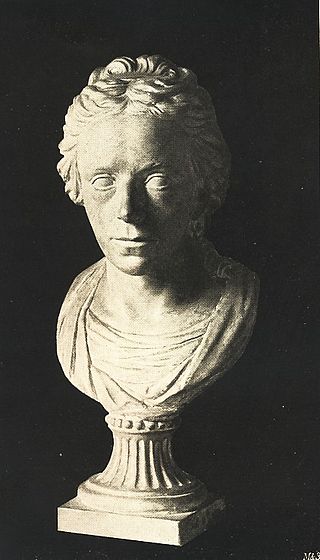
Louise Ernestine Christiane Juliane von Göchhausen was Chief Lady-in-Waiting to Duchess Anna Amalia of Saxe-Weimar-Eisenach. Known for her sharp wit, she became a close friend of Johann Wolfgang von Goethe.
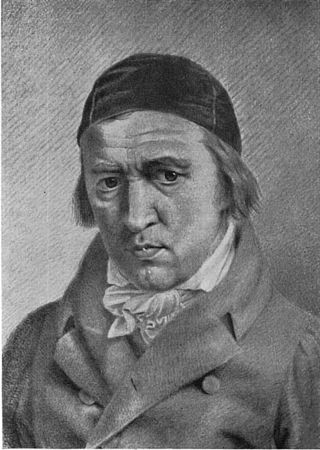
Johann Heinrich Meyer was a Swiss painter, engraver and art critic. He served as the second Director of the Weimar Princely Free Drawing School. A close associate of Johann Wolfgang von Goethe, he was often referred to as "Goethemeyer".

Catharina Elisabeth Goethe, born Catharina Elisabeth Textor, was the mother of German playwright and poet Johann Wolfgang von Goethe and his sister Cornelia Schlosser. She was also known by the nickname Frau Aja and the title Frau Rat.

Friedrich (Fritz) Bury was Court painter to the royal courts of Kassel and Brussels, a German painter born in Hanau. He studied first under his father Jean Jacques Bury, who was a goldsmith and professor in the Academy of Design in Hanau, and with Anton Wilhelm Tischbein. In 1780 he visited for two years the Kunstakademie Düsseldorf, where he met Johann Heinrich Lips, with whom he returned to Hanau at the age of 19 and two month later they traveled to Rome. From November 1782 to July 1785 he lived with a nephew of Tischbein, Johann Heinrich Wilhelm Tischbein, Johann Georg Schütz and Lips in a rear building of the Palazzo Piombino in Via del Babuino 51. Later they followed their landlord to Via del Corso no. 18, now known as the Casa di Goethe, as Johann Wolfgang von Goethe also lived and worked there for over a year.
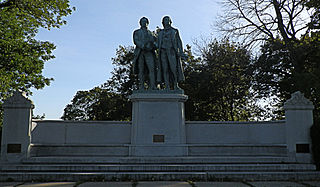
The Goethe–Schiller Monument is a public artwork by German artist Ernst Friedrich August Rietschel located in Washington Park, which is in Milwaukee, Wisconsin, United States. The bronze sculpture from 1908 depicts two men, Johann Wolfgang von Goethe and Friedrich von Schiller, one holding a laurel wreath and the other a scroll. The 12 foot artwork rests upon a 26 foot long granite base. The bronze sculpture is a recasting of the statue incorporated into the 1857 Goethe-Schiller Monument in Weimar, Germany.

Schloss Weimar is a Schloss (palace) in Weimar, Thuringia, Germany. It is now called Stadtschloss to distinguish it from other palaces in and around Weimar. It was the residence of the dukes of Saxe-Weimar and Eisenach, and has also been called Residenzschloss. Names in English include Palace at Weimar, Grand Ducal Palace, City Palace and City Castle. The building is located at the north end of the town's park along the Ilm river, Park an der Ilm. It forms part of the World Heritage Site "Classical Weimar", along with other sites associated with Weimar's importance as a cultural hub during the late 18th and 19th centuries.

The Park an der Ilm is a large Landschaftspark in Weimar, Thuringia. It was created in the 18th century, influenced by Johann Wolfgang von Goethe, and has not been changed much, preserving a park of the period. It forms part of the World Heritage Site "Classical Weimar along with other sites across Weimar bearing testimony to the city's historical importance as a cultural hub during the Weimar Classicism movement in the late 18th and 19th centuries".

"Harzreise im Winter" is a poem by Johann Wolfgang von Goethe, inspired by his ascent of the Brocken in the Harz mountains during the winter of 1777. He reached the summit in the heat of midday, in deep snow, with the landscape below him shrouded in cloud. The Brocken had always been a place of mystery, connected with witches and devils; where illusions such as the Brocken spectre might confuse an unwary traveller, and where few ventured by choice. This was the inspiration and the setting for his poem.

Baroness Ottilie Wilhelmine Ernestine Henriette von Goethe was a German socialite and the daughter-in-law of Johann Wolfgang von Goethe.
References
- ↑ 2 Brown's Parl. Cases 129, 1 Eng. Rep. 837; 4 Burr. 2408, 98 Eng. Rep. 257; 17 Cobbett's Parl. Hist. 953 (1813).
- ↑ te Winkel, Jan (1924). De ontwikkelingsgang der Nederlandsche letterkunde V, Geschiedenis der Nederlandsche letterkunde van de Republiek der Vereenigde Nederlanden (in Dutch). Vol. 3 (2 ed.). Haarlem: Héritiers F. Bohn. p. 401.
- ↑ "Das Stadtschloss Weimar/The Palace at Weimar" (PDF). Klassik Stiftung Weimar. 2010. Retrieved 2014-06-09.
- ↑ Martin Geck (2003). Bach. Haus Publishing. p. 25. ISBN 978-1-904341-16-1.
- ↑ Miriam Drake (20 May 2003). Encyclopedia of Library and Information Science, Second Edition -. CRC Press. p. 2073. ISBN 978-0-8247-2079-7.
- ↑ Milić Brett, Branislava (2014). Imagining the Morlacchi in Fortis and Goldoni (PhD). University of Alberta. pp. 1–213. doi:10.7939/R3MM45.
- ↑ Cándido María Trigueros (1774). El poeta filosofo; o poesias filosoficas en verso pentametro. En la Imprenta de Don Manuel Nicolàs Vazquez, y Compañia.
- ↑ BBC Two: Writing Scotland.